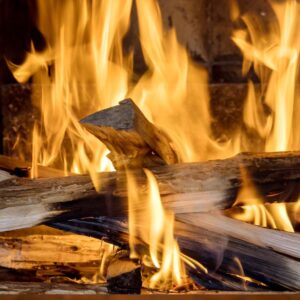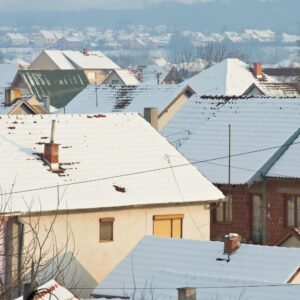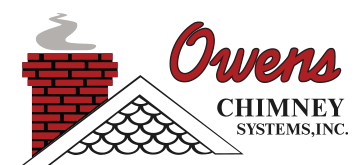As winter’s chill rolls across the landscape, there’s nothing quite like the cozy embrace of a crackling fire’s radiant heat in the fireplace. To make the most of it, there are a number of good practices to consider. These range from how you store your firewood to how you build fires to how you maintain the fireplace itself.
With thoughtful use, you can ensure your fireplace remains the heart of a reliable sanctuary during the winter months. Be sure to trust Owens Chimney for all of your chimney service needs. Call us now or book online today.
Properly Fueling Your Fire
 Choose quality firewood. Well-seasoned hardwoods, like oak or maple, burn cleanly and are long lasting. That means more warmth and less smoke – and therefore less hazardous creosote buildup in your chimney flue.
Choose quality firewood. Well-seasoned hardwoods, like oak or maple, burn cleanly and are long lasting. That means more warmth and less smoke – and therefore less hazardous creosote buildup in your chimney flue.- Invest in smart storage. It’s important to keep your firewood supply elevated and covered. Storing wood off the ground protects it from moisture, as does covering the top of your wood pile. Logs should be split for greater surface area exposure and not arranged too tightly. Leaving the sides of your pile open to air allows air circulation, which prevents mold and aids in drying.
- Use the oldest logs first. Use older wood first to allow greener wood the opportunity to fully season before use. You can tell wood is properly seasoned by its relative lighter weight or by using a moisture meter. If wood is freshly cut, the seasoning process will likely take six to twelve months.
Crafting the Best Fires
- Prep your fireplace. Before the burning season begins, have your fireplace or wood stove professionally inspected and the chimney swept. A chimney in good working order and free of debris will simply do its job better – venting smoke and gases out of your living space efficiently and with minimized risk of chimney fire.
- Remove ash, as needed. While some cooled ash should be removed when it becomes too thick, leaving about two inches of wood ash in your firebox will insulate the firebox and aid in starting new fires.
- Stack your firewood to burn better. Many people have their preferred way of preparing wood to burn. Some recommend a teepee technique, where logs are arranged in a triangular stack for efficient ignition. Others champion a top-down approach. Find the best approach for your household and setup.
What is the top-down burn method?
In this technique, the largest logs are placed across the bottom of the firebox, then subsequent layers are placed across the previous layer at a 90 degree angle. Each criss-crossing layer consists of smaller logs, then kindling crowns the log stack. After being ignited, sparks and embers slowly ignite the lower layers, providing a steady, sustained fire.
However you stack it, some space between logs will allow air circulation that will keep things going. And again – well cured firewood is your chimney’s friend. Combustion will be more complete if your firewood doesn’t contain too much moisture, making the use of your appliance easier, safer, more efficient, cleaner, and more enjoyable.
How To Maximize Fireplace Efficiency
Aside from proper maintenance and sweeping, there are other ways to get the most from your fireplace.
- When not in use, close your damper to regulate heat and conserve energy.
- Consider a zone heating approach to boost heat in only the areas of the house that are being used most throughout the day.
- If you’re looking for a major boost in efficiency, ask about having a fireplace insert installed into your open hearth firebox to maximize control over the heating process, as well as capture more heat in the home.
Are Wintertime Chimney & Fireplace Repairs Possible?
There’s a reason chimney professionals recommend spring and summer repairs. It’s not just a gimmick – temperate weather lends itself better to masonry repairs and curing.
 That’s not to say winter repairs can’t be done if a situation is urgent… The solutions just may be more complicated – and may inhibit the use of your heating appliance during some of the prime season for building fires.
That’s not to say winter repairs can’t be done if a situation is urgent… The solutions just may be more complicated – and may inhibit the use of your heating appliance during some of the prime season for building fires.
That said, step one in maintaining your wood stove, fireplace and chimney is thinking preventively. Schedule your next inspection for spring, and be prompt about making any necessary repairs. Keep an eye out for cracks, leaks, or reduced heating efficiency as these can be indicators of a problem. And if you do have concerns, reach out to a professional to help assess the best course of action.
Another reason for a spring inspection? The freeze/thaw cycle. Moisture in pores or small cracks in masonry that freezes will expand. Each time this occurs throughout winter, cracking and leaking is prone to increase. Addressing damage after the cold of winter has passed will help keep your chimney in proper working order.
Other important measures to take include asking about having your chimney masonry waterproofed (sealed) and ensuring a well-fitting chimney cap is in place. Both guard against moisture entering your chimney, saving you from a host of potential moisture-related issues.
Give Us a Call
Winter can bring its challenges, but if you stay ahead of those winter gusts and precipitation, you can enjoy the beauty of the season from the warmth of a well-functioning fireside. Need to schedule a chimney inspection? Book with us now – call or schedule online now.
